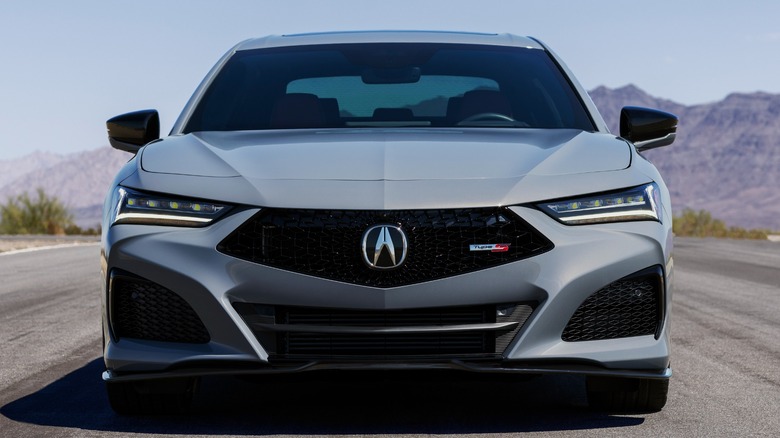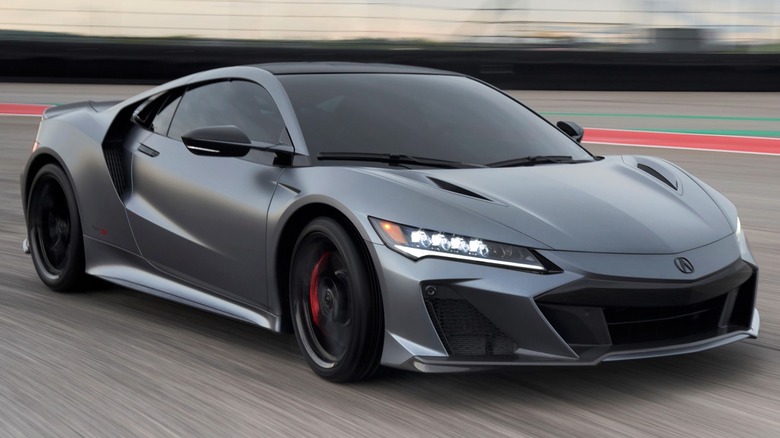What Is Acura's Super Handling AWD And How Is It Different From Regular AWD?
There are some major differences between 4WD and AWD, one of them being that the latter can be used constantly, whereas 4WD requires either off-road or slippery surfaces to function properly. The 1968 Jensen Interceptor was the first passenger car that came equipped with all-wheel drive, but the technology has come a long way since, with Acura's system being one of the most advanced to date.
Acura's Super Handling All-Wheel Drive (SH-AWD) first launched back in 2005 on the Acura RL. It's a technology that brings together two systems that were both developed around the turn of the century and used in Acura and Honda cars: Active Torque Transfer System (ATTS) and Variable Torque Management four-wheel drive system (VTM-4). While the terminology is a bit of a mouthful, basically, SH-AWD uses specialized components and computer software to quickly shift torque to certain wheels when cornering or detecting a loss of grip. While SH-AWD can send power to the front, rear, left or right-side wheels, other forms of all-wheel drive simply send power to all four wheels continuously.
Today, SH-AWD is in its fourth generation, and engineers have managed to make it smaller and enhance its capability. According to Acura, the latest SH-AWD can react 30% faster, which makes for even better control behind the wheel. We found just how much more a car grips the road with SH-AWD in our 2024 Acura TLX Type S review, where we noted the traction was on par with wizardry.
How exactly does SH-AWD improve handling?
Acura's ATTS technology (which is part of the SH-AWD system), uses two clutches, which are controlled electronically. These clutches regulate torque dispersal and send upward of 70% of the available torque to the rear wheels, then every bit of that power can be diverted to the outside rear wheel when turning the car.
With so much extra power going to that back wheel, it has the effect of greatly reducing understeer, by pushing the vehicle around the curve. Understeer and oversteer in handling greatly impact control, with the former causing the driver to take a much wider path during a turn than expected.
Imagine a vehicle making a sharp right turn, as it enters the corner, the weight of the car shifts, leaning away from the turn and onto the left side tires. With Acura's ATTS system, it detects the corner and as the center of gravity moves, it sends an ample amount of additional power to that left rear wheel, helping to propel the car through the turn more efficiently. Active Torque vectoring is another word for this technology, but unlike some systems which incorporate a brake to slow a particular wheel down, Acura continually sends power from side to side incredibly quickly, making the car almost feel glued to the road.
The NSX hybrid also featured SH-AWD but it worked a bit differently
The Acura NSX first appeared in 1990, stunning car fans with its exotic supercar performance, without the exorbitant price tag. When the second generation launched in 2016, the NSX had transformed into a hybrid, offering both a twin-turbocharged 3.5-liter V6, and a tri-motor electric configuration producing 573 horsepower.
But it wasn't all about output from under the hood, as Acura also incorporated the SH-AWD technology into their supercar. This time however, instead of mechanical connections present on other models, this hybrid distributes torque by assigning two of the electric motors for the front wheels, and the third motor aids the engine while the turbochargers build up pressure.
So, when launching from a stop, the NSX throws torque at the front wheels, while simultaneously pushing power to the back wheels via a rear differential. And of course, when cornering, the NSX SH-AWD can quickly and responsively send torque to either side providing the signature super-handling grip.
We covered the last iteration of this supercar during our 2022 Acura NSX Type S first drive, noting the automaker had managed once again to capture something special. While many enthusiasts were saddened by Acura's decision to shelve the car after its 2022 production run, rumblings in the automotive industry suggesting the Honda/Acura NSX may be going full EV for its next outing.


